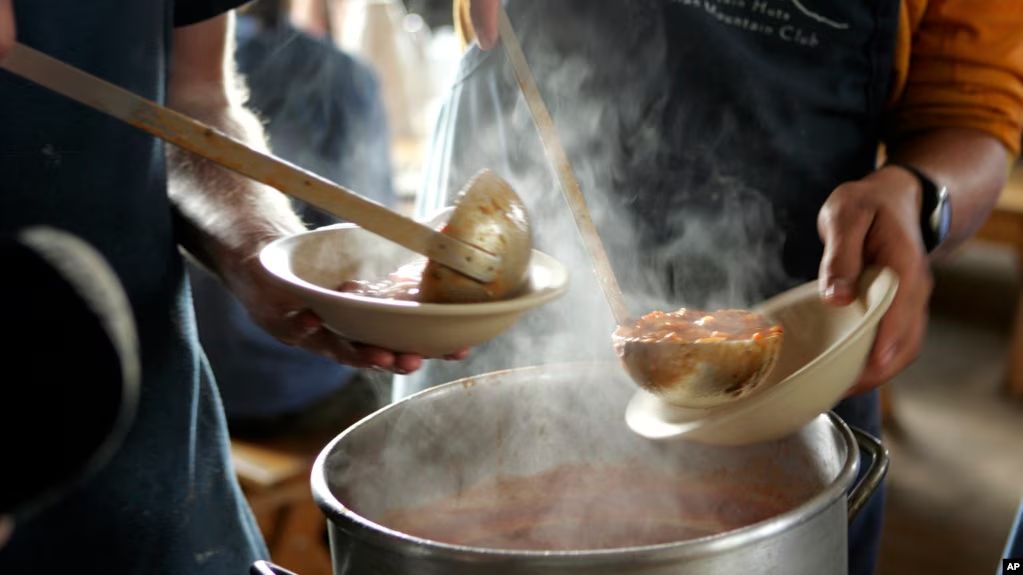Good Wintertime Meals Are Warm, Healthy and Tasty
Good Wintertime Meals Are Warm, Healthy and Tasty
今回は、アメリカの冬にぴったりの食材を使った食事に関する話題です。寒い季節だからこそ楽しめる旬の食材、「in season(旬の)」という表現も覚えておきたいですね。また、「produce」の名詞には「農産物」という意味もあることをご存じでしたか?「staple(主食)」や「savory(塩味)」など、食事の話題で知っておくと便利な単語もいくつか登場しますので、どんな食材や料理が冬におすすめなのか、関連語彙を使ってレッスンで話してみましょう。

1.Article
Directions: Read the following article aloud.
Winter is settling in across much of the United States, with dropping temperatures, snowfall and icy roads.
But the cold season does not mean weeks of lifeless, colorless meals. Diet and food experts say winter is a time to experiment. They suggest trying some of the season’s vegetables to cook a healthy meal that tastes good.
“Embrace the cold, embrace the winter and appreciate the bounty,” said Kristen Rasmussen. Rasmussen is a dietician and cook who teaches at the University of California Berkeley.
Here are some suggestions from nutrition experts on how to “winterize” your meals:
Staple fruits and vegetables are available all year in American food stores. But winter is also “high season” for a few special kinds.
Citrus fruits, including lemons, limes and oranges, are among the fresh fruit available in U.S. stores in the winter. Other produce we connect with the cold weather are pumpkins and root vegetables like sweet potatoes, parsnips, beets and radishes.
And do not overlook winter’s leafy greens. Rasmussen suggests including more chicory into your winter diet, like radicchio, escarole and endive. You can also try different kales and the leafy tops of root vegetables, like radish greens. If fresh choices are limited, experts say canned and frozen fruits and vegetables still have a lot of nutritional value. Just do not overcook them. Also make sure these foods do not have a lot of added salt or fat.
Dried fruits, including apricots, dates and raisins, are good for winter meals. Nuts can also be tasty, nutritious and filling.
“Without a doubt, there's a lot of nutritional benefit, even in dried (fruits),” said Linda Van Horn, a clinical nutrition epidemiologist at Northwestern University in Illinois.
“The benefit of it is that it's all contained,” Van Horn said. She noted that nutrients from the ingredients stay in the cooking liquid, or broth.
These meals are also a way to try out different beans and legumes, which Rasmussen called a “nutritional powerhouse.”
They are less costly than produce and provide an excellent source of protein and fiber said Alicia Henson. Henson is a dietician for children at the University of California San Francisco's Benioff Children’s Hospital.
Porridges — in the morning or beyond — are a good way to try out different grains.
“You can make it savory or sweet, you can put leftovers on top…,” Rasmussen said, “…or an egg.”
Eating foods that are “in season” can help people connect with the sources of their food and with their environment, experts say.
I’m Caty Weaver.
But the cold season does not mean weeks of lifeless, colorless meals. Diet and food experts say winter is a time to experiment. They suggest trying some of the season’s vegetables to cook a healthy meal that tastes good.
“Embrace the cold, embrace the winter and appreciate the bounty,” said Kristen Rasmussen. Rasmussen is a dietician and cook who teaches at the University of California Berkeley.
Here are some suggestions from nutrition experts on how to “winterize” your meals:
Fresh fruits and vegetables
Any produce is good. Only one in 10 Americans eat the recommended amounts of fruits and vegetables each day, the U.S. Centers for Disease Control and Prevention says.Staple fruits and vegetables are available all year in American food stores. But winter is also “high season” for a few special kinds.
Citrus fruits, including lemons, limes and oranges, are among the fresh fruit available in U.S. stores in the winter. Other produce we connect with the cold weather are pumpkins and root vegetables like sweet potatoes, parsnips, beets and radishes.
And do not overlook winter’s leafy greens. Rasmussen suggests including more chicory into your winter diet, like radicchio, escarole and endive. You can also try different kales and the leafy tops of root vegetables, like radish greens. If fresh choices are limited, experts say canned and frozen fruits and vegetables still have a lot of nutritional value. Just do not overcook them. Also make sure these foods do not have a lot of added salt or fat.
Dried fruits, including apricots, dates and raisins, are good for winter meals. Nuts can also be tasty, nutritious and filling.
“Without a doubt, there's a lot of nutritional benefit, even in dried (fruits),” said Linda Van Horn, a clinical nutrition epidemiologist at Northwestern University in Illinois.
Liquid meals: stew, soup or porridge
Soups, stews and porridges are foods that have a long history and are eaten in many cultures. They often are made using just one cooking pot which can ease the whole process. They all can be frozen easily for a later meal. And you can put just about anything in them.“The benefit of it is that it's all contained,” Van Horn said. She noted that nutrients from the ingredients stay in the cooking liquid, or broth.
These meals are also a way to try out different beans and legumes, which Rasmussen called a “nutritional powerhouse.”
They are less costly than produce and provide an excellent source of protein and fiber said Alicia Henson. Henson is a dietician for children at the University of California San Francisco's Benioff Children’s Hospital.
Porridges — in the morning or beyond — are a good way to try out different grains.
“You can make it savory or sweet, you can put leftovers on top…,” Rasmussen said, “…or an egg.”
Cook for others to nourish mind and body
Winter can be isolating for some people. So, join friends and family for meals even when it is not a holiday.Eating foods that are “in season” can help people connect with the sources of their food and with their environment, experts say.
I’m Caty Weaver.
Devi Shastri reported this story for the Associated Press. Caty Weaver adapted it for VOA Learning English.
Source:Good Wintertime Meals Are Warm, Healthy and Tasty
VOA
本教材は、the U.S. Agency for Global Mediaより許諾を得て、産経ヒューマンラーニング株式会社が編集しています。
テキストの無断転載・無断使用を固く禁じます 。
